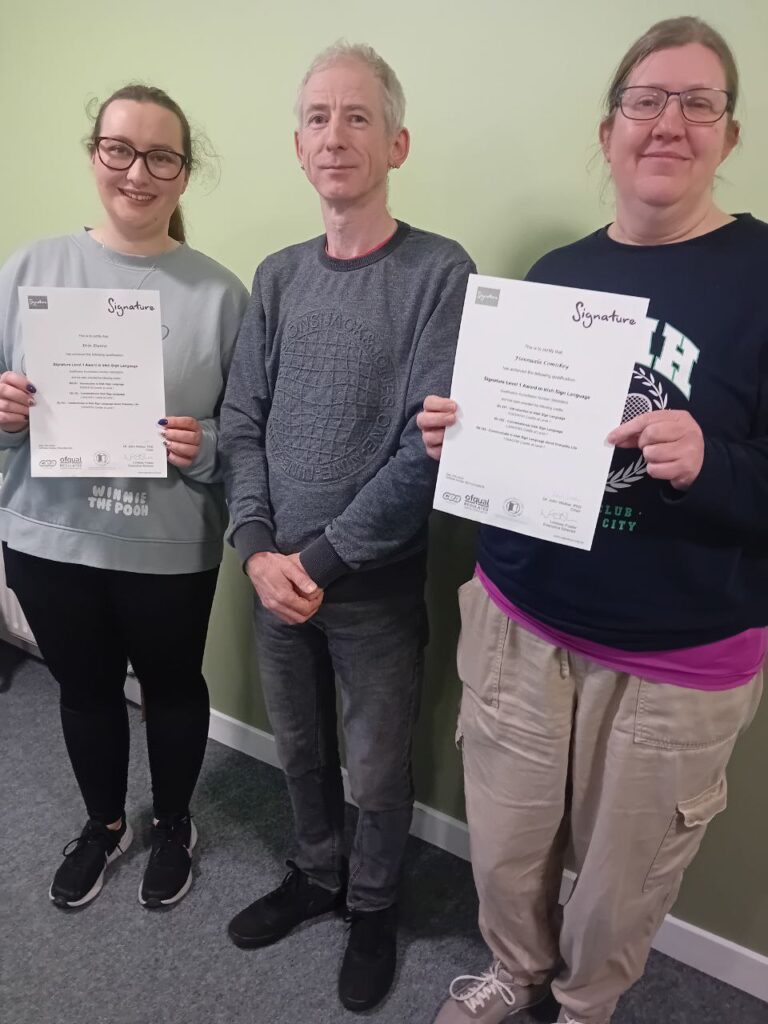I may speak five languages, but only sign will bring me closer to my brother
TV star Sinead Desmond tells John Cradden why she’s taking up a new challenge
Two of a kind: Sinead Desmond always understood her brother Conor, who is deaf, but is learning sign to be more involved in his life
By John Cradden
Wednesday December 08 2010
Some people are natural linguists, continuously learning new languages even as the rest of us struggle to master our native ones.
Sinead Desmond, presenter of TV3‘s Ireland AM, is one of them. She speaks no fewer than five languages, including Irish, Italian, German, French and “a little bit” of Spanish.
Now she is taking on another one. But while she might have learnt German or French purely out of fun or interest, she has a particularly strong incentive to learn Irish Sign Language (ISL). She wants to communicate better with her brother Conor, who is deaf.
Not that they seem to have difficulty communicating. Like any pair of siblings who enjoy a close relationship, they often finished each other’s sentences during our chat in a café bar in Dun Laoghaire.
As you might expect, Conor, who is 35 and two years younger than Sinead, is fluent in ISL having attended St Joseph’s School for Deaf Boys in Cabra and has lots of deaf friends.
Irish Sign Language is the language spoken by the deaf community in the Republic of Ireland, and which has been passed down through many generations.
Although he also speaks, ISL is his preferred language. So why has Sinead never learnt it until now?
“I never needed it to communicate with Conor,” she says. “We could always speak. I could understand him. He could understand me. There was never a problem, no confusion.”
Sinead can fingerspell words, which helps if they get stuck on the odd word while chatting.
But Sinead has another incentive to learn ISL. She was nominated by Conor to be one of the participants in a TV reality-style challenge organised by the RTE television magazine programme for the deaf, Hands On.
The producers, MindTheGap Films, embarked on a search for family and friends of deaf people who were willing to learn ISL but had never attended any formal lessons.
The producers arranged for them to attend ISL classes organised by the Irish Deaf Society once a week for four months, and to follow their progress on the current series of Hands On, which began next month.
The participants hope to obtain a FETAC qualification in ISL equivalent to Junior Cert level.
Sinead should certainly find many opportunities to practise with Conor. He works as a hairdresser in Kilkenny three days a week but now shares a flat in Dun Laoghaire with Sinead and her husband David. Even before that, they would see each other at least once every couple of weeks. Their parents now live in Crete so it’s just the two of them in Ireland.
So while there is nothing lacking in their relationship, Sinead is discovering just how important Irish Sign Language is to Conor.
“It was really to be a bigger part of Conor’s life, because when I go out with him and his friends, they wouldn’t have as good speech as Conor, and so I would be trying to talk to them with my own crappy, makey-uppy sign language.”
They can manage by lip-reading but Sinead often finds it unsatisfying. “They can understand me, but still, it’s not having a conversation, it’s not natural.”
So far Sinead has only attended three classes (recently interrupted by a short spell in hospital), but is already finding it fascinating.
One common misconception about ISL is that it is based on English.
‘It’s been very interesting, because I thought ‘OK, it’s just going to be English signing, we are just going to be speaking English but signing it’. But it’s not. It’s a completely separate language in its own right. And I love languages. I speak five languages.”
Irish Sign Language has its own specific grammar that is conveyed by using a combination of hands, face and body.
It develops within deaf communities, which means that ISL is different from British Sign Language or even American Sign Language.
It took many years of linguistic research to prove it, but few language academics would now dispute that sign languages, including ISL, have all the defining characteristics of a language. They’re just not spoken.
“Conor was telling me this and Wendy (Murray, the teacher) was telling me this, that you use your face a lot more when using ISL,” says Sinead. “So you are really expressive.
“Wendy was almost laughing at us because we were telling stories but our faces were almost set in stone because we were concentrating so hard on signing. She was like, ‘if you are happy, if you are sad, if you are confused, then show it on your face’.”
“Your facial expression conveys your tone of voice,” adds Conor.
There are estimated to be about 5,000 ‘native’ deaf ISL users and another 50,000 (friends, family, interpreters) who use it regularly. It is also understood the CSO is considering including a question about ISL in the forthcoming Census.
The other participants in the RTE Hands On ISL Challenge include a man whose wife is deaf and doesn’t want to be left out of the interaction in ISL between her and their young daughter, and a woman who wants to communicate better with her deaf sister-in-law.
“At the heart of every person’s reason is someone they love,” says Sinead.
“Somebody in their world, their family, friends, mother, brother, sister, brother-in-law, sister-in-law. They want to be able to communicate better with them.
“But we are all realising that it’s more about respecting that person’s world as well, and saying ‘I want to be able to communicate with you on your terms’.”
– John Cradden
Source:
Irish Independent






